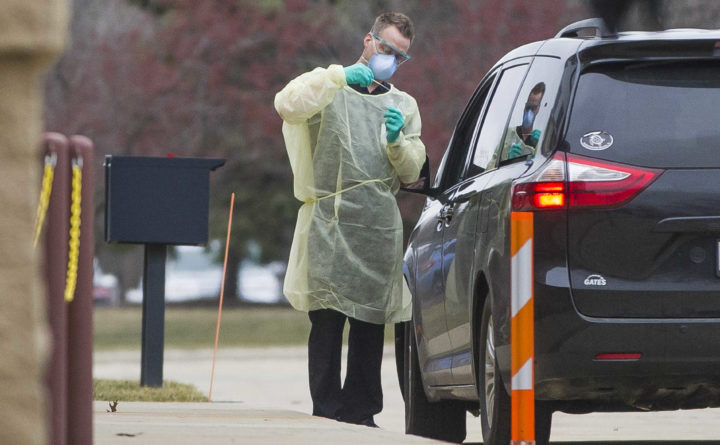

A health care worker tests a patient for the coronavirus in a drive-through site
The coronavirus continues to wreak havoc on the global healthcare system. Hospitals and doctors’ offices in some parts of the country are being overrun with patients all claiming to have the coronavirus. Meanwhile, facilities are running low on medical supplies like ventilators, facemasks, and other safety equipment. Emergency rooms and waiting rooms can easily lead to the spread of germs and bacteria as patients start filing in.
If your facility is starting to heed calls about potential cases of the coronavirus, learn more about how some hospitals and health networks are responding to the crisis while minimizing the risk to patients and providers.
A Coronavirus Hotline
California is one of the many states reeling from the effects of the coronavirus. Schools are being shut down, restaurants are shuttering their doors, and businesses are telling their employees to stay home to prevent the spread of infection. Social distancing is designed to help individuals avoid large crowds and gatherings where bacteria can easily spread from person to person.
As the pandemic continues, patients could easily start flooding into your facility, which could lead to overcrowding and the spread of bacteria. If just one of these patients has the coronavirus, it could easily spread among staff members and the rest of your patients.
To help ease potential congestion and contamination at facilities, Scripps Health has decided to set up a coronavirus hotline. Scripps is a nonprofit healthcare system in the heart of San Diego, California with 19 outpatient facilities. Many local residents, including low-income individuals and those without insurance, depend on Scripps Health for affordable access to healthcare.
If patients in the San Diego area suspect they may have the coronavirus, including flu-like symptoms such as shortness of breath, coughing, body aches, and fever, they can call 888-261-8431. The line is staffed with nurses who will ask patients about their health and related symptoms. Depending on how they answer, patients may be connected to a local healthcare provider via live video and audio for further consultation. The hotline will direct them to the MyScripps smartphone app.
If patients seem to have the coronavirus, they will be directed to one of the Scripps Health centers in the area, either an urgent care facility inside the city or one of the company’s three centers outside the city for additional testing and treatment, including Scripps Clinic Torrey Pines, Scripps Clinic Rancho Bernardo and Scripps Coastal Medical Center Vista. These clinics will only accept patients directed there through the nurse hotline.
Incoming patients will receive instructions in terms of where to park their car as well as a phone number for letting the staff know they have arrived. Staff members will then go out to their vehicle to administer testing and treatment.
Similar hotlines have been established around the country. In Michigan, Beaumont, Detroit Medical Center (DMC), Wayne County, Oakland County and United Way have established a coronavirus hotline for sharing updates with the public, diagnosing symptoms, and directing treatment efforts. Local residents can dial 248-551-7000 for assistance.
Another hotline is up and running in Albany, GA. Patients that use Phoebe Putney Memorial Hospital can call 229-312-1919 for information on testing, symptoms, and treatment.
Why It’s Important to Triage Patients Ahead of Time
The Scripps coronavirus hotline is designed to protect the entire San Diego community. Patients with the virus will be kept away from other inpatient visitors to prevent the spread of infection. Those with respiratory symptoms will not be allowed into these three healthcare facilities. Local residents can also call the number to learn more about their condition and find out if they have the virus without stepping inside a healthcare facility.
As Dr. Ghazala Sharieff, Scripps chief medical officer, said in an interview, “The health and safety of our patients, physicians, staff and community are our top priorities at Scripps. We are launching these services to protect all involved and to make sure our patients are getting the right level of care that they need.”
Without these services, local health clinics would likely fill up with patients, some of which may have the virus while others do not. Keeping all these patients in the same area can quickly turn your facility into a hotbed for germs and bacteria.
Tips for Managing the Pandemic
The virus will likely continue to spread in the coming days and weeks. Use these ideas to help your facility prepare for a surge in demand.
When we discuss students, we always mention their qualities. Those qualities show what they are…
If you or someone you know is juggling mental health issues alongside substance abuse, understanding…
For the last couple of weeks, the Israel-Hamas conflict has taken over the news cycle.…
Our eyes are invaluable, serving as our windows to the world. The ability to see…
Undoubtedly, one of the most demanding and challenging professions is nursing. Nurses work long hours in…
Echocardiography, or echo for short, is a key diagnostic test used by cardiologists to assess…